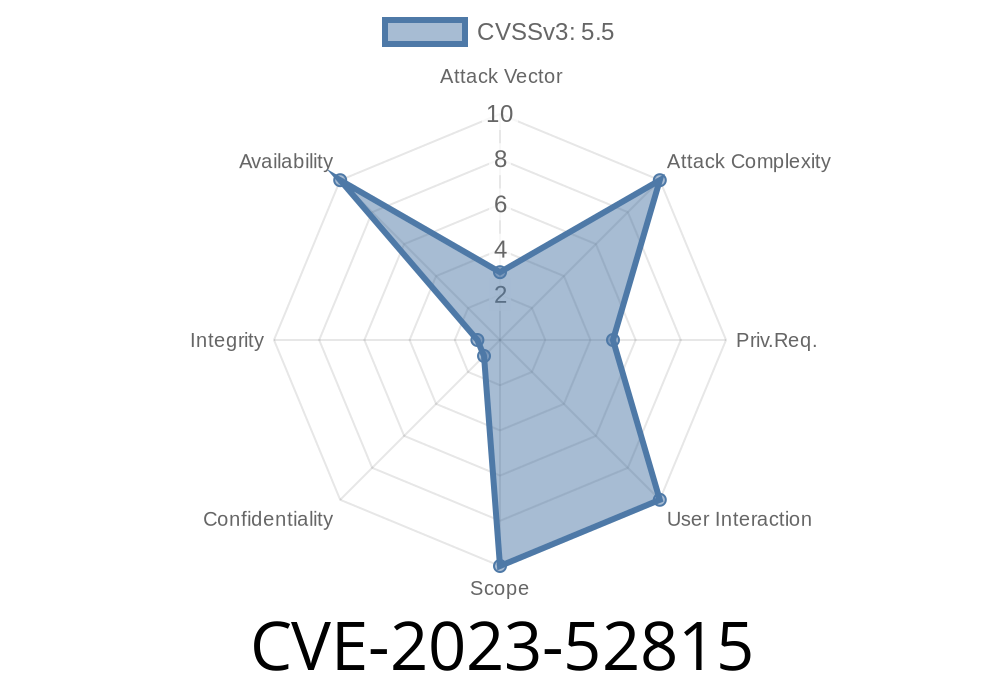Linux kernel bugs sometimes hide in plain sight, tucked away in the depths of graphics drivers. CVE-2023-52815 is one such bug—a subtle error that could crash your system because of a missing null pointer check in the AMD virtual KMS driver. In this article, we break down what happened, look at the code, and help you understand why even tiny mistakes in kernel code matter a lot.
What Is CVE-2023-52815?
CVE-2023-52815 is a vulnerability in the Linux kernel’s “amdgpu” subsystem, specifically within the “vkms” (Virtual Kernel Mode-Setting) part. This component helps virtualize AMD GPU resources for things like automated testing or virtual machines.
The bug itself is in a function called amdgpu_vkms_conn_get_modes(). This function tries to create and return display modes (like 192x108@60Hz) that a virtual connector supports. But the function can mistakenly use a NULL pointer if memory allocation or mode creation fails, leading to a kernel crash.
Here’s a simplified version of the problematic code in the Linux kernel
struct drm_display_mode *mode;
mode = drm_cvt_mode(connector->dev, 192, 108, 60, false, false, false); // vulnerable line
drm_mode_probed_add(connector, mode); // dereference, crashes if mode is NULL
If drm_cvt_mode() fails (for example, if memory allocation fails or double-free happens), it returns NULL. But the code above immediately dereferences mode with drm_mode_probed_add()—which can’t handle a NULL argument. The result: null pointer dereference, which on Linux crashes the kernel (a “kernel panic”).
What’s the Impact?
- Denial of Service (DoS): Local users (even unprivileged ones, if they have access to virtual graphics interfaces) can crash the machine.
- Not Privesc: This vulnerability can’t be used to “break out” or take over the system directly (e.g., gain root). It just makes things unstable.
Who Can Trigger It?
- Anyone who can cause a virtual AMD GPU connector mode to be queried—generally only users running virtualized environments or developer tools.
Real-World Exploit Example
A typical "exploit" for this bug would simply force the system to trigger the vulnerable code path, for instance with (pseudo) code like:
# In a QEMU virtual machine with virtual AMD GPU
xrandr --output Virtual-1 --mode 192x108
If drm_cvt_mode() fails (for example, due to low memory or internal race conditions), the kernel could panic.
Most of the time, drm_cvt_mode() works fine, so the bug doesn’t bite every day.
- But triggering a rare kernel panic makes the system unpredictable. For CI, desktops, or critical VMs, this is unacceptable.
The Fix: How Linux Stopped the Crash
The kernel maintainers fixed the bug by simply checking for NULL before dereferencing the pointer. Here’s the new, safe code:
struct drm_display_mode *mode;
mode = drm_cvt_mode(connector->dev, 192, 108, 60, false, false, false);
if (!mode)
return ; // Exit gracefully if mode allocation fails
drm_mode_probed_add(connector, mode);
That’s it! By adding a check (if (!mode)), the kernel avoids the tragic fate of dereferencing a bad pointer.
Official patch:
drm/amdgpu/vkms: fix a possible null pointer dereference
CVE Details:
Discussed Fix:
CVE-2023-52815 is a Linux kernel bug in the AMDGPU virtual driver.
- It could crash your system if a virtual display mode fails to allocate and the code tries to use a NULL pointer.
The fix is a straightforward check for NULL before using the pointer.
- Keeping these checks in kernel code is critical—you don’t want your entire machine to crash because of a simple programming mistake.
If you're maintaining a Linux system with AMD GPUs (real or virtual), update your kernel! Even small bugs can have big consequences.
*Stay tuned for more exclusive, clear tech breakdowns on the secrets hiding inside your operating system’s codebase!*
Timeline
Published on: 05/21/2024 16:15:19 UTC
Last modified on: 05/24/2024 01:14:29 UTC
